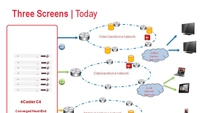Envivio targets multiscreen video delivery for cable operators at SCTE conference

At the SCTE Cable-Tec Expo in New Orleans last week, Envivio, a provider of live and on-demand multiscreen IP video processing and delivery) solutions, spotlighted its new Genesis architecture to help streamline the operations of video headends and content delivery networks (CDN). The Genesis architecture makes it easy for a facility to convert to IP-based video delivery and deliver services to mobile, PC and TV screens from a single integrated platform.
The new platform consists of a multiscreen headend for high-quality audio/video processing and compression, and the company’s Network Media Processors (NMP) that handle packaging, encryption and distribution inside the CDN. The encoded media is delivered from the headend to the NMPs in the intermediate Envivio Genesis mezzanine format, enabling operators to use a single headend to handle all of their processing requirements, regardless of the number and type of target devices and networks.
Current headends require separate silos of equipment to meet the individual requirements of an operator's broadcast, Internet and mobile services. The multiscreen headend eliminates the redundancies in such a system, using a single headend to handle video compression for all services. Encoding is performed once by a centralized 4Caster C4 system, which outputs a single Genesis intermediate mezzanine format that can then support all the required resolutions and bit rates for live and on-demand services for every device on the network.
The Genesis architecture requires only a single core content delivery backbone or satellite uplink for distribution of the common intermediate mezzanine format instead of carrying a specific packaged and encrypted format for each device, each on its own different delivery network. This dramatically reduces backbone bandwidth requirements and streamlines network management and monitoring.
Final packaging and encryption for distribution to specific devices and platforms is handled by NMPs that can be added as needed to support new devices without impacting the headend or the core network delivery backbone. The NMP also provides a logical platform for audience-specific content insertion, encryption and transport adaptation for different networks.
The NMP is presently in trial with the some of the world’s largest Cable and Telecom operators and is expected to ship in early 2011.
The professional video industry's #1 source for news, trends and product and tech information. Sign up below.
